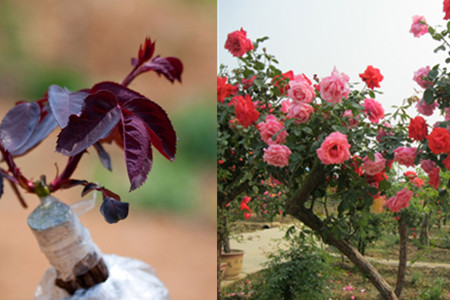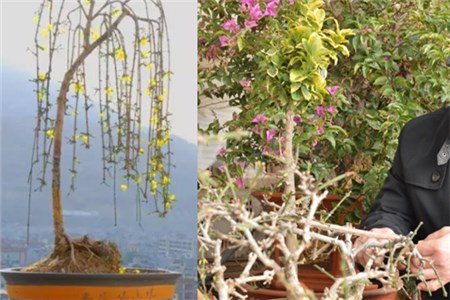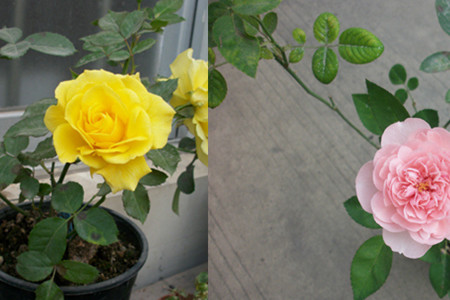What tree do you use to graft roses with rose flowers? you can choose.

In the past, the rose we saw was very low, and even if there were one or two trees that could grow tall occasionally, the branches would be very slender. Now, the roses growing on both sides of many roads have very strong poles and grow taller. Is this because their varieties have mutated? Of course not, there is such a rose because people grafted it onto other plants.
Moreover, friends should also find that the rose after grafting can grow larger and more flowers. So, which plants can be used for grafting with the rose?
1. Rose
A large part of the grafted roses we have seen are roses, because the two plants are not very different in habits, and they can be called "close relatives". However, not all roses can be used, and only those vines that have grown for many years and have grown sturdier can be used for grafting.
2. Roses
Many people say that the roses sold in the market are actually fake. They are all roses. We don't know what the truth is, but it is true that roses can be used for grafting. Many florists like to use this plant as a rootstock because it can make the rose more colorful.
3. Wild rose
In fact, not all roses are grafted with other varieties of plants, and some people use wild roses, because such plants are easier to survive and can grow and blossom even in a very bad environment.
These three kinds of plants are easy to use rootstocks, if friends have the energy, they can also try their own grafting.
Rose tree grafting rose tree planting
Tree-shaped rose, also known as rose tree and rose tree, is a new type of rose produced by a upright trunk by horticultural means (cutting, root cultivation, stem cultivation, grafting, pruning, shaping, etc.). Let's learn about the planting methods of rose trees.
Rose tree planting
If you want to breed rose trees quickly, you need to use double nurseries. One is the rootstock nursery and the other is the ear-picking nursery. What the two nurseries have in common is to choose flat, sunny, well-drained, moist, fertile, neutral slightly acidic soil with a PH value of 6 to 6.5. When ploughing, the base fertilizer per mu is applied according to the following formula: farm manure 5000 kg, phosphorus nitrate 20 kg, urea 10 kg, carbofuran granule 5 kg.
The rootstock nursery bed is 1.2 meters wide, cutting Baiyutang or Rosa farinosa as rootstock, the row spacing is 40 cm, and it is cut from May to July every year. After insertion, pay attention to seedling management, the Beginning of Winter will re-cut all the branches, leaving only one or two buds on the strong branches, the rest of the weak branches can be cut off by the root, and take appropriate measures to survive the winter.
Rose tree grafting
1. Disinfection of cutting tools before grafting: when grafting, it is necessary to ensure that the cutting surface of the rootstock must be flat while ensuring the alignment of the rootstock layer. The binding action should be nimble and quick to avoid oxidation and discoloration of the cut surface.
two。 Selection and storage of scions: the selection of rose scions is directly related to the survival quality of seedlings and the formation of robust grafted plants. The stored scion can be grafted at any time, eliminating the trouble of picking, saving a lot of time and grafting at any time.
Management of Rose Tree
Rose is a kind of strong positive flower that likes light, and tree rose is no exception. If the plants are given insufficient light, poor ventilation or excessive shade, the branches of tree-like rose will become slender, the leaves will become thinner, and the nutrient accumulation will be poor, which will eventually lead to poor plant growth, small and small flowering, dim flower color, short flowering period and so on.
Because the tree-shaped rose flowers bloom many times a year, the requirement for nutrition is relatively higher than that of other flowers. In the whole growing season of tree rose, fertilizer should be applied several times appropriately, that is, fertilizer should be applied once after each flowering of tree rose, so as to restore the growth of rose plant as soon as possible. In topdressing, we should pay attention to the proportion of nitrogen, phosphorus and potassium, not only a single nitrogen fertilizer or phosphorus and potassium fertilizer. Otherwise, it will cause symptoms such as only growing branches and leaves or not being able to pregnant buds normally.
The above is the editor to introduce to you the planting methods of rose trees and other related information, I hope it will be helpful for you to plant rose trees! What kind of tree can be grafted? what are the benefits of rose grafting?
Rose flowers are beautiful and varied. They often bloom at 04:00. They are very popular. We all know that rose can be grafted, so what kind of tree can be grafted rose, what are the benefits of rose grafting? Next, let's have a look together!
What kind of tree can be grafted with rose
The main factor affecting the survival of rose grafting is the affinity between scion and rootstock. The so-called affinity is the ability that scion and rootstock are the same or similar to each other in internal tissue structure, physiology and heredity, so as to combine with each other. Rose belongs to Rosaceae. The best rootstocks of grafted rose are all kinds of wild roses, such as Ten Sisters, Rosa przewalskii, Rosa mandshurica, Rosa macrophylla and so on. These varieties have developed root system, strong disease resistance and exuberant growth, which can give sufficient nutrients to the roses that want to be grafted.
Grafting Propagation technique of Rose
Rose grafting is commonly used as rootstock, bud grafting and branch grafting. The survival rate of bud grafting is high, which is generally carried out from August to September, and the grafting site should be as close to the ground as possible. The specific method is to make a T-shaped incision in the skin with a bud grafting knife on one side of the stem branch of the rootstock, and then select buds from the middle of the branches that grow well in the same year. After inserting the buds into a "T"-shaped incision, tie them with a plastic bag and give proper shade so that they can heal after about two weeks.
What are the benefits of rose grafting
1. Exuberant growth: the rootstocks of grafted rose are roses with exuberant growth, so the stems, leaves and flowers are obviously better than those planted on the ground.
2. The disease is mild: the branches and leaves of grafted rose are higher from the ground, ventilated and transparent, so there is almost no disease.
3. Less land: the traditional three-year-old seedlings cover an area of about 0.09 square meters, while the grafted rose covers an area of only 0.001 square meters.
4. Convenient management: the trunk of the rose has no thorns, it is easy to manage, and the grafting height can be controlled, and it can be arranged arbitrarily according to the form of the courtyard.
5. One plant with many flowers: three or five varieties can be grafted on one rose, and more than 30 varieties can be reached in ten plants. Courtyard cultivation is enough.
- Prev

The pruning method of primrose bonsai is simple, practical and easy to learn.
Yangchun March, all things return to spring, nature, communities, gardens, mountains everywhere revealed and permeated with the smell of spring. Learn to make a bonsai of primroses to keep the breath and vitality of spring around us for a long time.
- Next

Introduction of rose cuttage technology to teach you how to propagate plants
Rose, also known as monthly red, is an evergreen semi-evergreen low shrub of Rosaceae. Rose flowers, usually red, or pink, occasionally white and yellow, can be used as ornamental plants, can also be used as medicinal plants, also known as rose flowers
Related
- Fuxing push coffee new agricultural production and marketing class: lack of small-scale processing plants
- Jujube rice field leisure farm deep ploughing Yilan for five years to create a space for organic food and play
- Nongyu Farm-A trial of organic papaya for brave women with advanced technology
- Four points for attention in the prevention and control of diseases and insect pests of edible fungi
- How to add nutrient solution to Edible Fungi
- Is there any good way to control edible fungus mites?
- Open Inoculation Technology of Edible Fungi
- Is there any clever way to use fertilizer for edible fungus in winter?
- What agents are used to kill the pathogens of edible fungi in the mushroom shed?
- Rapid drying of Edible Fungi

